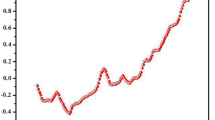Abstract
This overview will describe briefly key segments of the hydrogen energy cycle from production using various feedstocks to its end use in fuel cells to generate electrical and thermal energy. The paper will also discuss the larger societal context, the so-called “hydrogen economy,” in which such production and use of hydrogen may take place. Although most of the public attention on hydrogen has been focused on its potential as an alternative energy source to petroleum and other fossil fuels, a hydrogen economy will encompass much more than a substitution of one energy source by another. Widespread use of hydrogen as an energy carrier can transform our society in much the same way that personal computing technologies have. This transforming power arises from the unique capability of hydrogen to link renewable energy resources and zero-emission energy conversion technologies. Hydrogen can be produced from locally available renewable resources, such as solar, wind, biomass, and water, and converted to electricity or fuel at or near the point of use with only heat and water vapor as “emissions.” Hydrogen also lies at the confluence of two emerging trends that will shape our energy future during the first quarter of this century: greater reliance on renewable energy sources and the shift from large, centralized power plants to smaller, decentralized facilities located at or near the point of use. This paper describes these emerging trends and the role of hydrogen in linking them in a way that could transform our society.
Similar content being viewed by others
References
B. Schlag S. Suresh with and Y. Inoguchi: CEH Marketing Research Report Hydrogen (August 2004) p. 6.
T. Joseph: Liquid Hydrogen Transportation and Storage presentation to the U.S. Fuel Council Workshop Washington DC May 25 2005.
A. Bain J.A. Barclay T.K. Bose F.J. Edeskuty M.J. Fairlie J.G. Hansel D.R. Hay J. Ohi C.E. Padro and M.R. Swain: Sourcebook for Hydrogen Applications (Tisec Inc. Montreal Canada 1998) p. 2.
B. Marion C. Riordan and D. Renne: Shining On (National Renewable Energy Laboratory Golden CO n.d. available at http://www.rredc.nrel.gov/solar/pubs) Chapter 2.
For more information on renewable resource data and mapping go to http://www.rredc.nrel.gov
The material on production technologies has been compiled from information available on various web sites located on or linked to http://www.eere.energy.gov/hydrogenandfuelcells.
Proton Energy Systems at http://www.protonenergy.com
Hydrogen Generation: On-site and On-demand Stuart Energy at http://www.stuartenergy.com.
More information on current options for hydrogen delivery is available in chapter 3.3 of the DOE’s Multi-Year Research Development and Demonstration Plan: Planned Program Activities for 2003–2010 available at http://www.eere.energy.gov/hydrogenandfuelcells.
For more information concerning hydrogen storage technologies see chapter 3.2 of the DOE’s Multi-Year Research Development and Demonstration Plan: Planned Program Activities for 2003–2010 available at http://www.eere.energy.gov/hydrogenandfuelcells.
For more information concerning the DOE’s safety codes and standards activities see chapter 6 and 7 of its Multi-Year Research Development and Demonstration Plan: Planned Program Activities for 2003–2010 available at http://www.eere.energy.gov/hydrogenandfuelcells.
http://hcsp.ansi.org/default.asp.
http://www.hpath.org/TechnicalReport.pdf.
Directed Technologies Inc. Air Products Chemicals BOC Gases Electrolyser Corporation Inc.: Praxair Inc.: Hydrogen Infrastructure Report (July 1997).
D.S. Scott: For better or worse. Int. J. Hydrogen Energy 29 449 (2004).
Author information
Authors and Affiliations
Corresponding author
Additional information
Note: some of the material in this paper was previously prepared by the author for inclusion in Towards a Secure and Renewable Hydrogen Economy for Asia: Fundamentals, International Experience and Steps Forward, co-authored with C. Lowry, P. Middleton, and D. Renne, and available at www.nrel.gov/hydrogen.
Rights and permissions
About this article
Cite this article
Ohi, J. Hydrogen energy cycle: An overview. Journal of Materials Research 20, 3180–3187 (2005). https://doi.org/10.1557/jmr.2005.0408
Received:
Accepted:
Published:
Issue Date:
DOI: https://doi.org/10.1557/jmr.2005.0408




